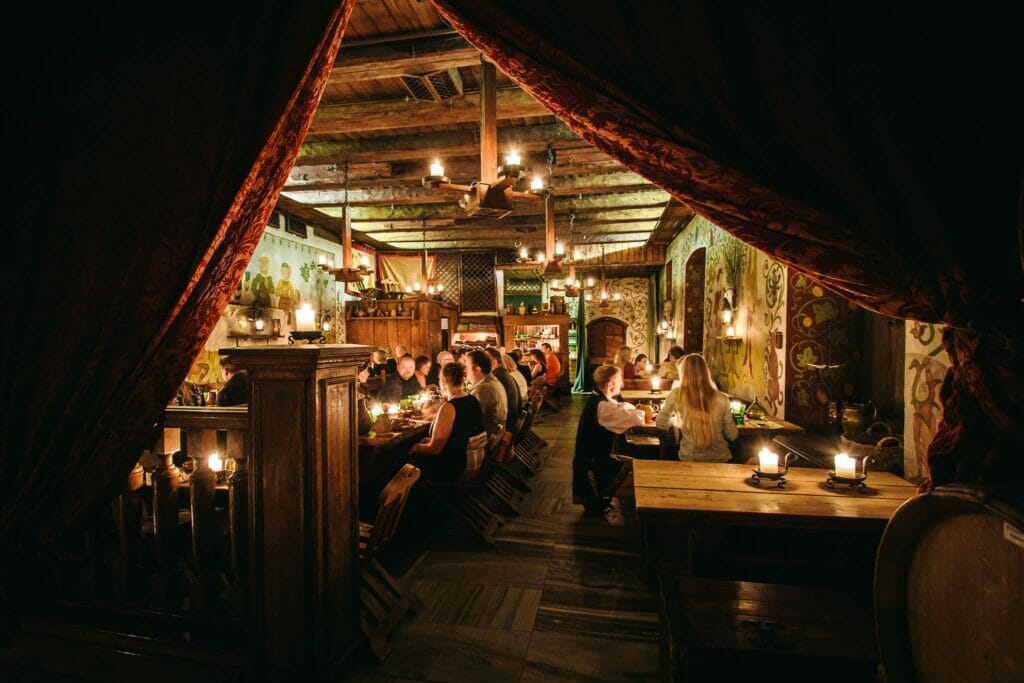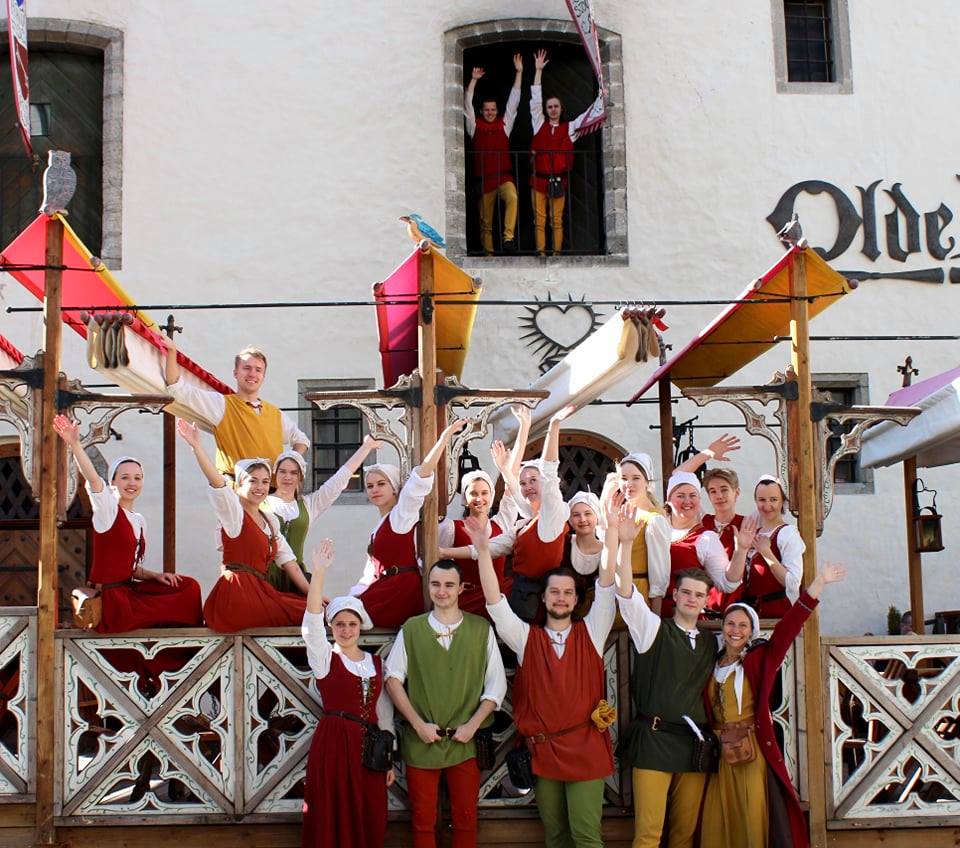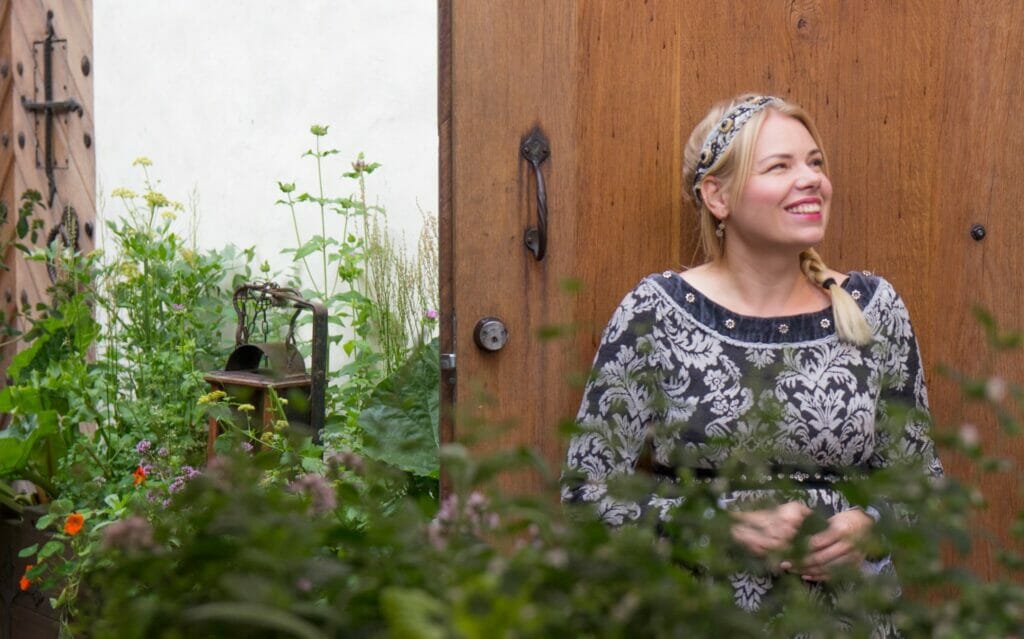For the past decade, the Olde Hansa restaurant in Tallinn, Estonia has been successfully scaling their professional staff 3x during peak seasons through a community approach to their contingent workers’ scheduling.
I sat down with their general manager Aile Laansalu.

A 15th-century restaurant experience—in detail
Olde Hansa is a medieval-themed restaurant in the heart of Tallinn’s Old Town, serving an authentic medieval experience to their guests. The dining halls fill three floors of a warehouse built in the 17th century, originally used as a trade center by international merchants.
Guests are welcomed in an authentic environment without electric lights and are entertained by traditional performances of dance and music. All of the staff working in the dining room and shop are dressed in full medieval costumes and are trained to follow the old Hanseatic customs. They use authentic language when talking about the dishes, all cooked according to original medieval recipes.
A community of on-demand staff
The year-round number of staff members is about 70 for Olde Hansa, but this surges up to 180 during medieval festivity dates and summer months with good weather, when Tallinn becomes a tourist magnet. Because the skills and culture take months to learn, recruiting temp staff for each peak season is out of the question.
“Originally the community club was a system meant to accommodate our staff members who were not able to work full time. For example, when someone decided to take up additional studies, our choice was to either provide flexibility or lose a well-trained employee,” says Aile Laansalu.
She uses the DISC personality test to qualify the hires best suited for the roles: “The same personality traits that make them excellent waiters, also push them to stuff their life with multiple experiences, overburdening their schedules. Most of our service staff is young, 22 years on average. They are excited to work with us many days in a row, then take several weeks off for their exams or a trip abroad.”
The community club sends a regular newsletter listing open shifts, and prompts list members to pick up the hours they are able to fill.
“Over the years, I learned to balance the number of people in the club. I needed to be confident that the members can fill my schedule gaps while giving everyone enough opportunities to come in regularly and keep their skills up to date,” Aile explains.
The flexibility for on-demand shifts allowed Aile to keep her best staff involved and engaged even with multiple distractions in their personal lives.

A personal approach really pays off
What’s your model for success with on-demand staffing? “The endless time I’ve invested in my people,” is Aile’s answer.
“It’s important to keep the focus on the individuals and make them feel that they belong with us. The moment they feel like numbers in a spreadsheet, they will become detached. Especially when they’re on-demand, each shift will be a special event in their week. As the manager, I need to acknowledge that.”
Another major topic that comes up is transparency and accountability, especially from the manager’s side. Throughout the years, Aile worked out a clear system for dispatching and confirming shifts that was understandable for everyone involved.
Once a batch of open shifts was announced, club members have a clear time frame to sign up for the hours. After the deadline, Aile confirms all allocated slots.
“My experience is that personal agreements are much more durable than any official signature on a paper. When I do the paperwork with my club members at the beginning of each year, we discuss the expectations in person. I ask them to try and pick up at least one shift each week. It isn’t a requirement on their contract, and we don’t follow up on anyone for picking up less. But they all do their best, and we are always able to fill out all schedule gaps.”

Eight virtues to define the culture of a community
The Olde Hansa community strategy follows medieval traditions. A journeyman will become a craftsman after successful training under the masters. Over its 20 years of operation, about 400 staff members have earned the craftsman title.
All communication and training is built around eight pillars of virtue – Human Respect, Trustworthiness, Friendliness, Courage, Eagerness to Learn, Fair-Mindedness, Staidness and Justice.
Each recruit will choose a personal virtue at the beginning of their journey and will be secretly tried for that virtue by their colleagues. Those who successfully passed the training months are given their personal medieval name and a guild ring to wear.
“The eight virtues is a perfect way for us to document our company culture. Even our staff manuals are written from the perspective of the virtues, and this consistency really aligns everyone in the Olde Hansa community,” explains Aile.

Keeping the club tight and active
The staff can join the on-demand club only after earning their craftsman title. “Everyone in the club has gone through 3-4 months of basic training full time, and are honoured with their personal medieval name and ring. Each year we send out personal invitations addressed to their given name to renew their loyalty to the guild, which meant confirming their participation in the club,” Aile says.
She also makes sure the communication stays with active staff members only: “When someone can not promise to pick up any shifts during the upcoming season, we exclude them from weekly communications to keep the group tight. Of course, they still receive a personal invitation to join the next season.”
Some roles are more likely to enjoy on-demand
Of course, not everyone can be a fan of flexible work and unexpected schedules. According to Aile, some of the roles never took off with the on-demand scheme.
“Our kitchen and cleaning staff have little interest in the club. They also tend to get very different results on the DISC personality test, and are more likely to value a more stable lifestyle, getting less enjoyment from sudden adventures.”
The risks of on-demand work
As gig workers are not eligible for benefits, the COVID-19 crisis was a major lesson for on-demand workers everywhere – also in Olde Hansa.
As the restaurant remained closed throughout the lockdown periods, full-time employees were able to claim unemployment benefits that don’t apply to staff members on on-demand contracts.
“It’s been tough explaining the difference between full-time and on-demand contracts to the young community members. While everyone was treated equally in their roles at the workplace, the difference of contract type now has major implications on their life in the pandemic.
I really hope there will soon be better job security options available for gig workers. Flexible contracts allow a certain type of people to enjoy their life to the fullest, and it’s an unfair game where they’re not entitled to public benefits even when over the course of a year the hours worked may actually sum up equal to our full-time employees,” says Aile.
Olde Hansa opened its doors again in spring 2021 with a mix of full time and on-demand staff to serve medieval feasts to both locals and tourists.